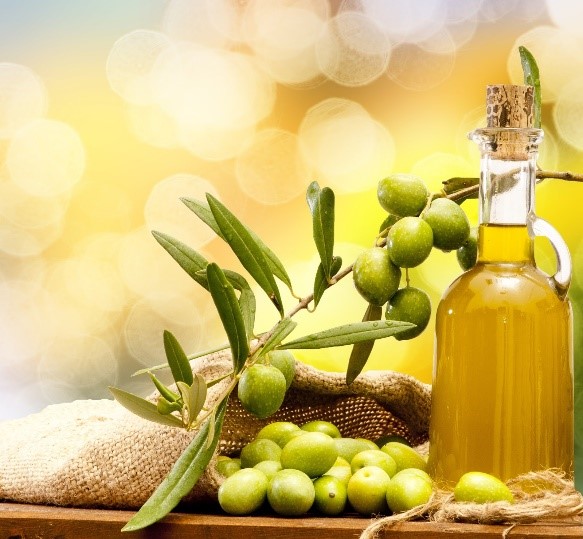
Oil with a green to ripe fruity taste, moderately bitter and a strong aftertaste.

It is in old maritime trade registers that we found the first traces of olive oil, almost 4000 years BC. J.-C.
Olive oil comes only from the fruit of the olive tree. Loaded with symbols, the olive tree is a tree representing longevity, hope, peace, victory, strength and fidelity. Over the centuries, it has accompanied the representations of many Mediterranean populations (Greek, Roman, Egyptian, Lebanese, etc.) and has made some of them rich. Today, olive oil production comes mainly from the Mediterranean basin: 70.8% of world production comes from Spain, Greece and Italy. French production represents only 1%.
Olive oils are classified into 3 main families of products corresponding to specific extraction criteria and measurements of free acidity expressed in oleic acid:

Virgin olive oil is obtained only by mechanical or other means, under conditions that do not cause alterations in the oil. It has not undergone any treatment other than washing, centrifugation Centrifugation is a process of separating compounds from a mixture, according to their density differences, by subjecting them to centrifugal force. and filtration. The acidity of olive oil expressed in oleic acid represents the main fatty acid found in it. The acidity determines the category to which the olive oil belongs as well as its use. A low acidity level means that the oil was produced under optimal conditions with a very short time between harvest and extraction.
Read more...
It is virgin olive oil whose free acidity expressed in oleic acid is at most 0.8g/100g. It is the most common in the Canadian market and is considered the highest quality oil.
It is a single-origin oil whose free acidity expressed in oleic acid is a maximum of 2g/100g. It is also very common on the market, but it is more often used for cooking.
It is virgin olive oil whose free acidity expressed in oleic acid is greater than 3.3g/100g. It is intended for the refining industries or for technical uses. It is the raw material for the development of refined olive oil
These are the oils that must undergo a treatment that does not lead to changes in the initial glyceric structure before consumption. This is a physical refining, called "neutralizing distillation", which aims to maintain or improve the organoleptic characteristics (taste, neutral smell, clarity, light yellow color), nutritional characteristics and the stability of fatty substances.
Read more...
Refined olive oil is obtained from lampante virgin olive oils through refining methods. It has a free acidity, expressed as oleic acid, of more than 0.3g/100g. This is intended for cutting and not for consumption.
This oil is developed by blending refined olive oil and virgin olive oil suitable for human consumption. Its free acidity expressed as oleic acid is a maximum of 1g/100g.
These are oils obtained by processing olive pomace. Pomace is the solid residue resulting from oil extraction. Processing is done with solvents or other physical treatments.
Read more...
It is an oil obtained from crude olive pomace oil using refining techniques that do not lead to changes in the initial glyceric structure. Its free acidity, expressed as oleic acid, is a maximum of 0.3g/100g. This oil is intended for cutting and not for consumption.
It is an oil developed thanks to the blend of refined olive pomace oil and virgin olive oils suitable for human consumption. Its free acidity expressed as oleic acid is a maximum of 1g/100g.

There are a multitude of different terms that can indicate the origin of a bottle of olive oil: "made", "product of", "imported by", "packaged". Single-origin olive oils are pressed, packaged and exported from the same country. Olive oils that are made from a blend of olives from multiple countries or pressed and packaged in different locations will list all countries of origin on their label. The single origin of an olive oil has no direct effect on the quality of the product. It simply ensures freshness and fluidity in the process of obtaining the final product intended for consumption.
Which country produces the best olive oil? There is no clear answer to the question since it is not the country of origin, but rather the cultivar, the climate and countless other factors that determine the taste and quality of an olive oil olive. Italy, Spain and Greece are probably the three best known producers. Croatia and Turkey have also produced some of the best oils in recent years. In the United States, California produces excellent olive oils, although Texas, Arizona and Georgia are also growing suppliers.
Generally speaking, pure Spanish olive oil tends to be more "fruity," while pure Italian oil leans toward "grassy." The oils from Greece are more flavorful and peppery. However, even within these categories there are wide variations depending on the ripeness of the olives, the types used and other factors. Also, as noted, many olive oils are sourced from a combination of different countries. Use these basic profiles as a starting point, but feel free to experiment with different selections.
Learn more about the Origin
| Country | Production average in tons |
|---|---|
| Spain | 1317 |
| Italy | 296 |
| Greece | 269 |
| Tunisia | 209 |
| Turkey | 188 |
| Morocco | 140 |
| Portugal | 94 |
| Algeria | 20 |
| Lebanon | 20 |
At Adonis you will find olive oils from multiple different origins including:

Oil with a green to ripe fruity taste, moderately bitter and a strong aftertaste.

Oil with a ripe fruity taste, moderately bitter and slightly strong.

Oil with a fruity, slightly bitter and strong taste.
Our advisors are always available to suggest oils according to your needs in the kitchen. Feel free to venture out and try specialty oils, flavored and from different countries. You will find, in the oil aisle Marché Adonis, 4 categories of oil: